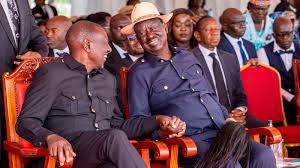Killed by Protest, Paid Back Later? Kenyan Governemnt’s Compensation Plan—Oil for Accountability or Political Band-Aid?

The Official Story
In early August 2025, Kenyan President William Ruto announced the formation of a 15-member task force to develop a framework for compensating victims of protests in Kenya since 2017. The task force, chaired by Professor Makau Mutua, has 120 days to complete its work and is expected to recommend payment structures for those injured or killed during demonstrations.
Ruto described the initiative as “a commitment to healing and reconciliation,” noting that many victims — including families of those who died — have waited years for justice. The government emphasized that the process would be inclusive, consulting civil society, human rights organizations, and political leaders.
The announcement follows months of deadly protests in 2024 and early 2025, where security forces were accused of using excessive force to disperse crowds. It also comes amid mounting political pressure from the opposition, growing public distrust in law enforcement, and calls for systemic police reform.
That’s the neat, press-release version. Now, let’s talk about what’s hiding behind the ribbon-cutting smiles.
What We Could have Missed!
1. Timing Is Everything — Especially in Politics
The government says the compensation plan has been years in the making. But the timing couldn’t be more politically convenient. The announcement landed just as Ruto’s administration faces a credibility crisis over police brutality, with human rights groups releasing damning reports on extrajudicial killings during protests.
It also neatly diverts attention from the growing public demand for criminal accountability. Instead of focusing on prosecuting officers accused of firing live rounds into crowds, the conversation shifts to how much a human life is “worth” in shillings.
2. The Optics of Inclusion vs. The Reality of Power
Yes, the task force has respected names — Makau Mutua, a legal scholar and human rights advocate, among others. But critics point out that a government-appointed committee is not the same as an independent inquiry. Without prosecutorial teeth, this body can only recommend, not enforce.
And while consultations with civil society are promised, past commissions — think the 2013 Truth, Justice and Reconciliation Commission — saw their findings shelved or selectively implemented. Without a legal framework to guarantee implementation, this could become yet another expensive report gathering dust.
3. The 2017 Backdate Question
One interesting detail is that the framework will cover victims since 2017, not just the recent 2024–2025 protests. On the one hand, that’s inclusive and acknowledges past injustices. On the other, it conveniently lumps multiple political eras into one package — blurring distinctions between different administrations’ culpability.
If you lost a son in the 2017 post-election violence, your claim is filed in the same pile as someone injured last year. That’s tidy for political memory — but messy for historical accountability.
4. The Money Problem
Kenya’s public debt is at a record high, and budget deficits are squeezing social services. Where will the funds come from? No clear budget allocation was announced alongside the task force. That raises the risk of “compensation pledges” becoming IOUs — political promises that outlast the politicians themselves.
Moreover, without a transparent valuation process, the payouts could be arbitrary, fueling more resentment than healing. We’ve seen this movie before with land compensation and state project displacements: some get millions, others get bus fare.
5. The Unspoken Stakeholders
Mainstream coverage rarely dwells on the police officers themselves — the ones who pulled triggers or ordered live fire. Compensation may soothe victims’ families, but without systemic police reform, those same officers could be deployed to “manage” the next protest.
And then there’s the silent political calculus: compensating victims without prosecuting perpetrators sends a quiet message — the state will pay for the damage but won’t change the system causing it.
Let’s be honest: Kenya’s compensation plan feels a bit like serving dessert after burning down the kitchen.
Imagine a boda boda rider whose leg was shattered by a rubber bullet in 2024. He’s been out of work for months, bills piling up. One day, a government officer knocks:
“Habari yako? Here’s a cheque… no, we still haven’t arrested the guy who shot you, but here’s some tea money. Oh, and please vote for us next year.”
Or picture a grieving mother in Kisumu being told:
“Your son’s death was unfortunate. Here’s some compensation. We’ve also put the same officer who shot him in charge of protest control for the next election cycle. Hakuna matata.”
The irony is rich: the same state machinery that inflicts the harm is now positioning itself as the benevolent healer. It’s a bit like a pickpocket offering you bus fare home after stealing your wallet.
Even the task force’s name — Framework for Compensation of Victims of Demonstrations and Civil Unrest — sounds like it was designed to be read only once and forgotten. Try fitting that on a campaign poster.
Compensation without accountability is a leaky bucket. It can temporarily ease public anger, but unless the root causes — police brutality, lack of independent oversight, and political impunity — are addressed, we’ll be right back here after the next protest.
Money may heal some wounds, but justice heals trust. And without trust, every cheque is just another IOU in the ledger of public betrayal.
The question isn’t whether victims deserve compensation (they do). The question is whether this government will ever match its payouts with prosecutions. Until then, this is less “healing” and more “hush money.”
Source: All Africa
More Articles: Media Wall